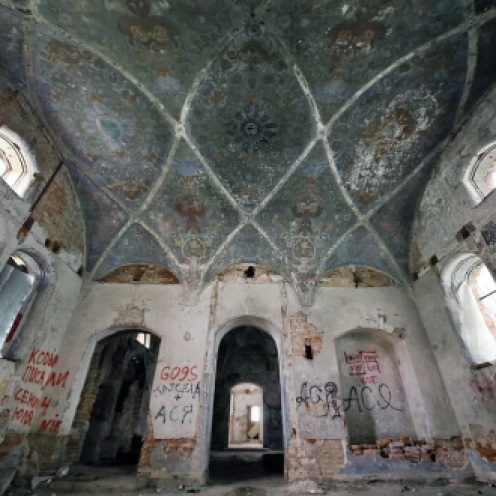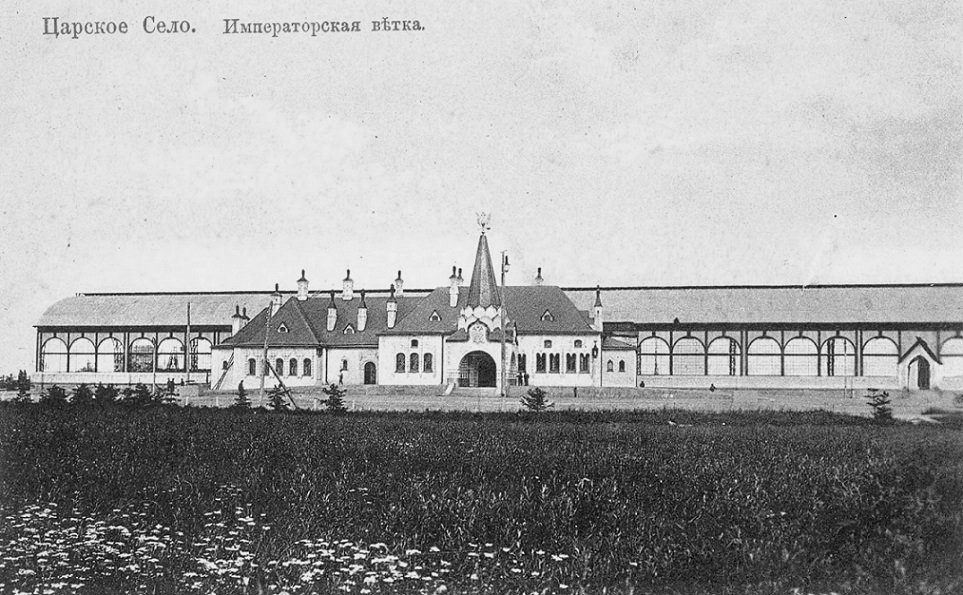Update on the restoration of the Imperial Railway Pavilion at Tsarskoye Selo
PHOTO: the Imperial Railway Pavilion [aka as the The Tsar’s Train Station] at Tsarskoye Selo and it’s architect Vladimir Aleksandrovich Pokrovsky (1871-1931)
NOTE: links to other interesting articles are highligted in red below – PG
Further to my August 2023 announcement that the Imperial Railway Pavilion at Tsarskoye Selo would be restored, I am pleased to provide the following update, which includes photos [taken in March 2024] of the progress being made on this important historic project, one which is closely connected to Emperor Nicholas II.
The building is currently hidden under scaffolding and outdoor construction hoarding, as experts carry out the restoration of the facade, it’s historic elements and install a new roof. This work can be seen in the photos published in this article, all of which were taken a few weeks ago.
The Imperial Railway Pavilion [aka as the Tsar’s Train Station] is a registered cultural heritage site of federal significance, an act which saved the building from destruction. Despite the fact that the building has not been used since the 1930s, it has been preserved in fairly good condition. The unique building will be restored to its original. In addition to the building itself, the 200-meter passenger platform and canopy will be reconstructed and the unique paintings which once decorated the walls and ceilings of the interior, and which have been partially revealed by restorers, will be revived.
The next stage, after a detailed study, will be the design, and then the restoration. The concept of using the building as a museum after the completion of the work will also be worked out.
The restoration work on the Imperial Railway Pavilion is part of a comprehensive development proect which includes the nearby Feodorovsky Gorodok, and other buildings to their original pre-revolutionary look.
The original wooden Imperial Railway Pavilion and the covered platform were constructed in 1895. They were intended to receive Imperial Trains arriving at Tsarskoye Selo through the Aleksandrovskaya Station, which is situated north of the pavilion on the St. Petersburg-Warsaw railway line.
On 25th January 1911, the wooden station was destroyed by fire. It was decided to erect a new stone building on the same site by the architect Vladimir Aleksandrovich Pokrovsky (1871-1931) with the participation of a graduate of the Academy of Arts Mikhail Ivanovich Kurilko (1880-1969).
The new pavilion was designed in the Neo-Russian Style beloved by Nicholas II. The Fepdorovsky Gorodok, the Feodorovsky Sovereign Cathedral, the Sovereign’s Martial Chamber, and the barracks of His Majesty’s Own Convoy were all built in the same style. Together, they form an architectural ensemble in which motifs of ancient Russian architecture were used. In addition, the planning and design of the Imperial Railwat Pavilion was influenced by the Imperial Railway Station, which has survived to this day at the Vitebsky Railway Station in St. Petersburg.
The front part of the building consists of three halls. In the center there is a square lobby with a front porch, large enough to accomodate automobiles and carriages. The halls on the sides of the vestibule were intended for the Emperor and his retinue: on the south side was the Tsar’s Hall, on the north side – the Retinue Hall. A metal canopy was built above the platform and tracks, adjacent to the eastern façade of the station.
Paintings became an unusual decoration of the walls and ceilings of the building’s interior. They were made using a tempera-glue technique on plaster. A unique painting has been partially preserved [see photo below] to this day, which will allow experts to restore it in full to its original.
During the First World War of 1914-1917, the Imperial Railway Pavilion was used to receive wounded Russian soldiers, who were transferred to the hospital established by the Empress Alexandra Feodorovna in the Feodorovsky Gorodok. And after the Revolution of 1917, it was renamed the Uritsky Pavilion and was used as a dormitory for workers of the Track Repair of the Mechanical Plant.
The Tsarist emblems were removed from the building’s facade, and the ceremonial halls were divided by walls. The building began to lose its former grandeur and ceremonial appearance: the porch was adapted for the kitchen, furniture, lamps, objects of decorative and applied art were lost.
Now in the 21st century, a new life awaits the former Imperial Railway Pavilion. Following completion of the reconstruction of the building and restoration of the interiors, the Board of Trustees of the Tsarskoye Selo Station Foundation, will discuss proposals for the future use of the building.
© Paul Gilbert. 16 April 2024












































You must be logged in to post a comment.